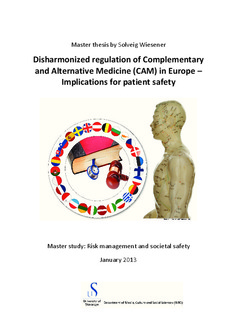Disharmonized regulation of complementary and alternative medicine (CAM) in Europe - implications for patient safety
Master thesis
Permanent lenke
http://hdl.handle.net/11250/184764Utgivelsesdato
2013Metadata
Vis full innførselSamlinger
- Studentoppgaver (SV-IMS) [1384]
Sammendrag
3 Summary
3.1 Research question and Objectives
Patient safety is a highly prioritized area within the provision of public and private health
care services in both the European Union (EU) as a whole, member states, as well as in
associated states. Risk governance giving preference to patient safety, includes regulation
as an important management tool. Complementary and Alternative Medicine (CAM) is, in
Europe, regulated either as conventional, complementary or alternative medicine, or not
regulated at all. CAM regulation is, however, different in each of the 39 European
countries included in the CAMbrella WP2 survey. Consequently an essential question is;
What are the patient safety implications of the European disharmonious landscape of
health regulation?
The master thesis consists of the following documents; this summing up document, the
attached FoKoM article, and the attached conference discussion paper. Analyses and
facts are based on the three CAMbrella EU FP7 project reports describing the status of
CAM regulation in 39 European countries and in the EU/EFTA/EEC.
The objectives for the research are: to describe the status of CAM regulation in Europe
with a patient safety focus, to highlight international theory dealing with patient safety,
especially the role of regulation, and to analyse whether CAM regulation in Europe is in
accordance with current theory dealing with risk governance and patient safety.
3.2 Materials and Methods
CAM can be regulated both within and outside the national public health care systems. It
was therefore necessary to perform a combined search for both conventional and CAM
health care regulation in each country. Materials and methods used for data collection
are: documents and web sites, meetings and personal communication, and
questionnaires. A literature search to identify official law documents and regulations was
performed in national web sites/databases, as well as scientific and non-scientific journals
and web sites. Searches were performed in the web sites/databases EUROPA and EUR-lex
to identify European Union (EU) official legal documents. Personal visits, including
meetings with the Ministries of Health (MoH), CAM practitioners and CAM associations
were made to selected countries, CAM conferences and EU associations.
It has been difficult to find appropriate methods to describe European CAM regulation in
a uniform, European terminology where national legal traditions are understood and
referred correctly.
3.3 Results and Discussion
Current risk governance and patient safety theory emphasize regulation as an important
risk management instrument. We found no harmonization of, or comparable, CAM
regulation between states, regions or in the EU, except for adapting legislation to EU
directives on medicinal products.
The Directive 2011/24/EU on patients' rights in cross-border healthcare states that
patients should be able to make informed treatment choices, and healthcare
professionals are supposed to provide safe and effective treatments for European
citizens. According to the FoKoM article and Birmingham conference paper, European
patients may encounter substantial differences in regulation of and the professional
background of apparently identical CAM providers and treatments both nationally and
between countries.
The regulation of CAM is so unclear that information given to patients on treatment
efficacy and, -risk factors and their resulting risk perception are sub-optimal. National
health authorities seem to regulate CAM based on insufficient basic information about
risk factors, and regulation is consequently not balanced between risk reduction and risk
tolerance. By analysing each step of the regulation process, we should find indications of
how and if harmonized national and EU regulation of CAM may ensure increased patient
safety and CAM treatment quality in Europe.
Seen from a patient safety perspective, it is difficult to see a “CAM treatment security
system” where both patients and authorities know the skills of the providers, and where
the providers’ performance of the modalities is standardized. However, we do not have
research evidence to claim that CAM patients are more exposed to unsafe treatment
offered by non-medical providers than treatment offered by regulated health personnel.
3.4 Conclusion and Recommendations
CAM in Europe is not regulated in accordance with current theory dealing with risk
governance, risk regulation and patient safety.
European patients make their CAM treatment and provider choices based on insufficient
and not trustworthy information. The diversity of European CAM providers’ skills and
regulation may challenge patient safety.
The above situation hampers CAM research, establishment of an efficient supervision
system for health care providers, and reduces expected impacts of a governmental risk
governance system on patient safety.
Health authorities in Europe should raise attention to how CAM risk governance and CAM
regulation could be embodied within the regulation of national health care services.
The physiotherapy model of educational harmonization, research and modality
standardization could be used as a template for the regulation of CAM treatments.
Treatment standardization, CAM terminology clarifications and provider harmonization
together with CAM research, will probably strengthen the safety of CAM patients in
Europe. A Directive on CAM could be developed more or less in parallel with the
Directives 2011/24/EC and 2005/36/EC.
Beskrivelse
Master's thesis in Risk management and societal safety
